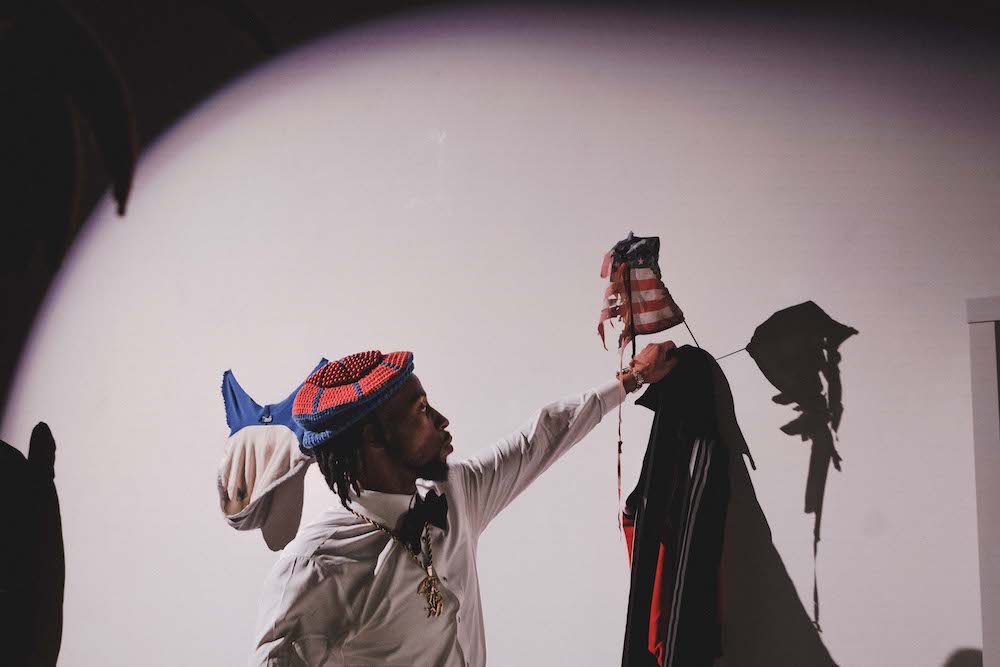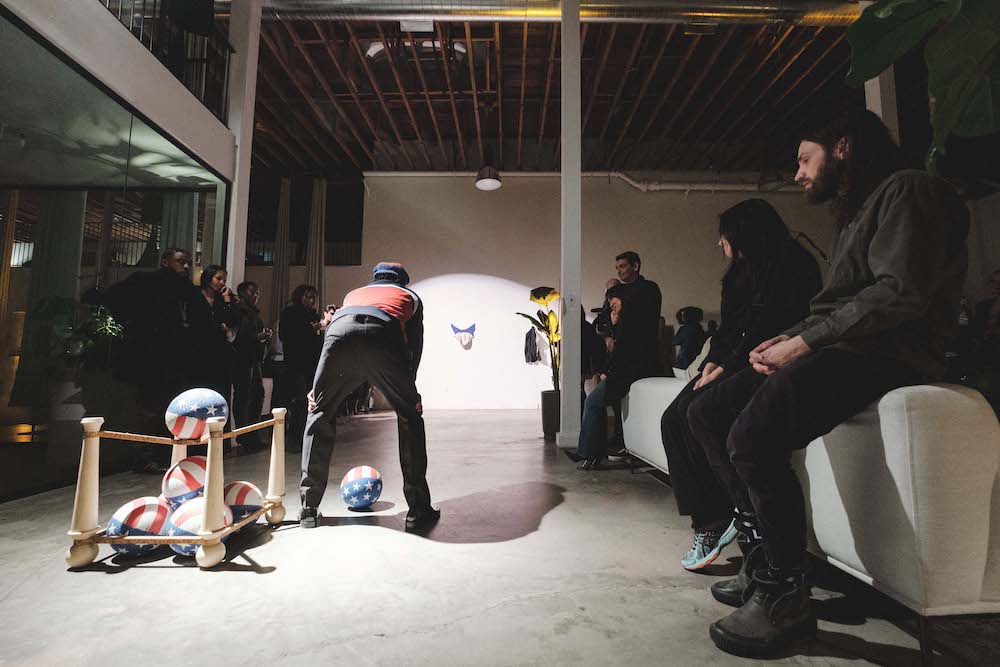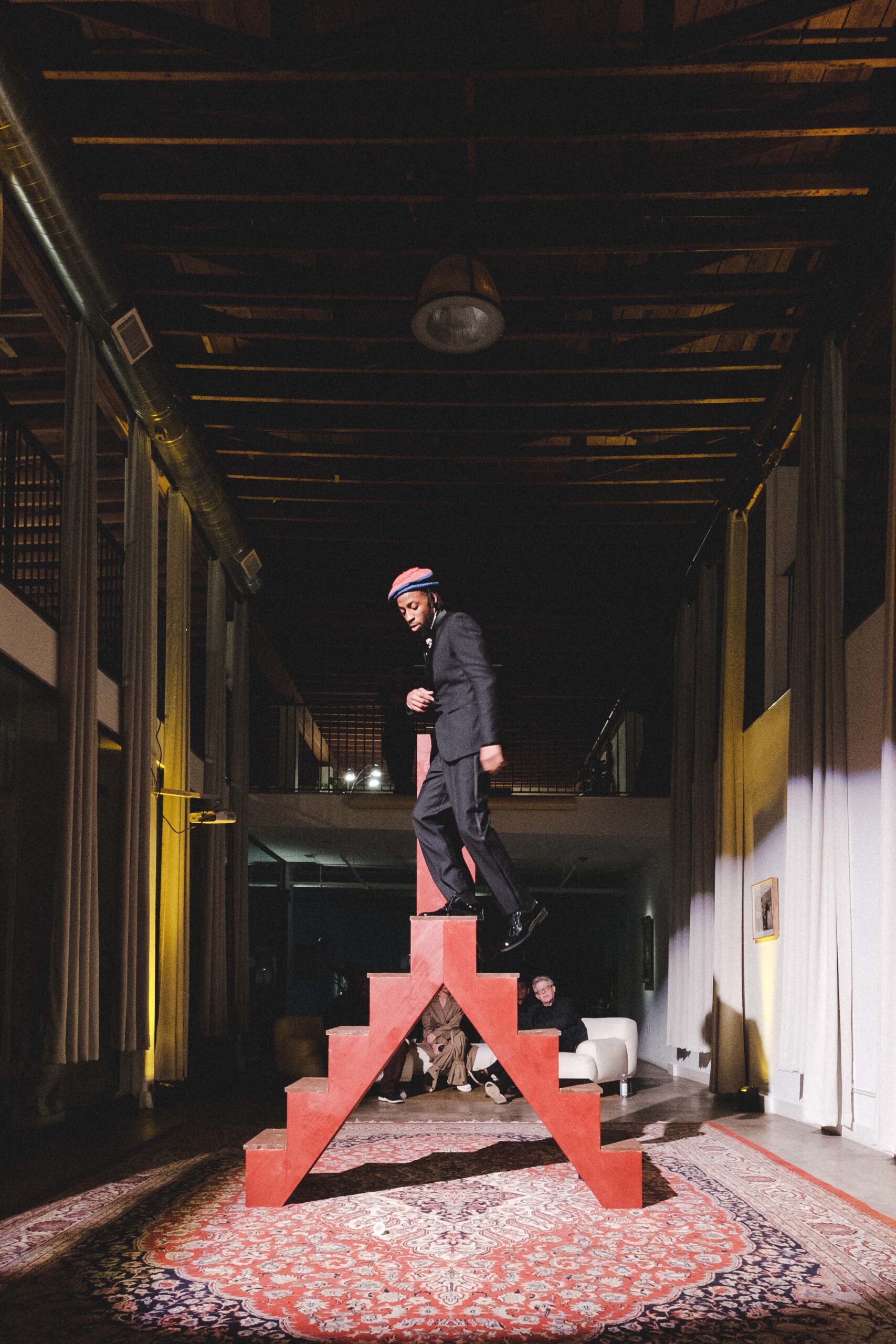
26.03.2023
An Interview with Daniel Tyree Gaitor-Lomack

Grandma: There is a profound intentionality that lies in the symbols and mythology of I AM THE AMERICAN DREAM: the coins in the hoodie’s hood that speak to change in the hood; the dodgeball game that alludes to dodging the System. What are the themes you are exploring with I AM THE AMERICAN DREAM?
Daniel Tyree Gaitor-Lomack: I don’t really look at them as themes. Maybe I see them as anthems sung over and over again and when the voice gets tired it struggles, scratches and cracks. Information has become the new tea. The power to bring the voice back are these works. This attempt garners simplicity, which is linguistic and charmingly profound. I want people not to forget that no matter how you look at it, reality still exists and must be enlightened whenever there is a shadow of a doubt. These symbols show a timeline from youth to adulthood. The playful freedom of games. Knowing each game has deeper lessons. Just like the game of life. Some of our lives are played with a little bit more danger. The Black Life first and foremost and then others who sadly fall into the categories as well.
G: Each of the acts of this multi-layered performance is radical in its own way. How did you begin to work on this series? Can you tell us more about how each segment came about and how they are tied together?
DTGL: It was a pattern in my life that became more clear within my work. How certain works respond in ways to the old and new world take over my thinking. This young and dumb naive country we call the USA. The turmoil that lingers every time I dream. At times being pushed not to use the color palette of red, white and blue over and over again because it is so American. Then letting go of the idea of being American or judged as so. It was almost supernatural. I watched these works build up over a course of time and just said to myself it’s time to do something heroic with them unlike this false idea of a patriot. Seeing big flags waving in the dark skies in Texas while I’m literally leaving a performance I did in the light of raising funds for Planned Parenthood in Dallas. I can’t make this shit up. All I can do is make it out and make it possible for others to do as well. Masterpieces through performance and conceptual thinking. Not racial paintings that become financially marked up through predominantly white ecosystems within the arts for the sake of white capitalistic survival and so forth. It’s not all bad but damn it the scale doesn’t lean in our favor when this happens. These works are the root of Black survival and we need to teach the rest of the system that our survival unleashes a genius that empowers the future and fights in the present through our past which is still extremely visual today. The works… Magic Man was passed on to me by one of the greatest entertainers to ever live. His name was Bill “Bojangles” Robinson. He invented the stair dance. That symmetrical wooden staircase you see was performed first by him. A tap dancer. The greatest of all time. At multiple points I found myself battling the tropes of Black performance and the lack of respect towards the legacy of it. It powered the souls of many and built the TV industry we know today. So the cables that hang out on the coat hook resemble a being with a hat. That’s called ‘Bootleg Cable’ and actually elevated the thought of this ongoing work. It’s something everyone I know had at least once in their life. I know I did. Especially in the hood. Which brings me to ‘Change In the Hood’. Something that was also passed down to me by David Hammons but more as a response and continuing of the conversation when it comes to the many nuances of the hood diaspora, symbology and reality. In this work coins were collected during my travels from Europe, United Kingdom, Mexico and America. The hood is inverted on the wall and holds these coins proudly. There’s a blue stain in the hood which is symbolic for the term “Blue Blood”, which speaks to the dark tradition of imperialism and skin complexion. Change in the hood is just something that needs to happen all around the world. I remember being younger and hustling with two cans in each hand standing in front of grocery stores to raise money for my future. Trying to get out the hood. The sounds of the coins that would drop in the cans from hand to hand reminds me of the sounds of the coins that drop in the hood once one is thrown and makes an impact. It’s very metaphorical and as simple as that. It deliberately speaks to the financial crisis in low income neighborhoods in America and across the world. The inequities of the American dream. That’s why ‘Dodge The System’ is so important. It never amazes me what this country’s political system throws in our direction. My mother used to tell me I had two strikes: one that I am Black and two that I am a Black male. Imagine growing up not trying to strike out? Never being given a fair count. The system is rigged for us to be tagged and bagged. That’s a tragic mindset to live by. Somehow I managed to stay on my feet and survive up until this point. Dodging it all. The FBI, CIA, DEA, IRS and mostly the USA. The alphabet boys are a hit squad. So yeah it’s a game of dodgeball. Need I say more?

G: We want to hear more about your relationship to performance though, and how it has been integral to your art. Throughout your career, you have explored the space between sculpture and labor. You have invented your own artistic language with these public and kinesthetic conversations, and often describe performance as a final act to your art practice. Tell us about that.
DTGL: Performance has protected me. It has shattered any stereotype anyone can ever throw on me. It’s like teflon in the art world. I didn’t need a biennial, institution or performance platform to do this. That fine line isn’t for everyone but it can be when they see me do it. That’s the importance of it. There’s plenty of lives I’ve changed through it. Subconsciously and directly. It unified who I am with where I belong. Where I belong is in the hearts of the people. This is endless for me.
G: So, is there always an element of performance incorporated into your pieces?
DTGL: It’s in my work’s DNA now. I don’t even have to try. I let it be and when the time comes I open up a metaphysical archway where people can see and hear for themselves. It distinguishes my name.
G: As your performance looks for ways to defy the System, do you think how your artistic language and aesthetic can exist independent of the framework of capitalism and white supremacy? Or how do you reconcile that relationship? Do you feel more Black artists are being railroaded or subconsciously nudged into expressing the formalized “universality” of a white aesthetic, especially when rewarded by capitalist success?
DTGL: Absolutely. The young ones especially, because it’s very fast paced today. That railroad you speak of has a bullet train that is selling artists’ wolf tickets. Everyone is jumping on board, not just the artists. Artists are becoming outnumbered by corporate advisors, entities and opportunists who hawk the numbers and market as a necessity. Treating art like real estate. They want the shiny look but become blinded and can’t see what’s behind it. So much talent being watched in a giant scope. They don’t know I already molded my Blackness into holiness and given that same light a soulful purpose. My language is so cultural it’s free. I am still independent no matter what it may look like. It’s tough to keep up with me because I move on my own when I want to. At my own expense and sacrifice. The framework of capitalism comes with tempered glass. What’s behind that is the true power. As an artist I’m ready to face that true power and that’s my choice. It’s the same choice I have to respond to the wrongdoings of society. Strategically piece by piece and one action after another. Nonetheless, there is a source that is driving us to be this way. Remember what doesn’t come out in the wash will come out in the rinse. As far as a white aesthetic goes, I think it would be wrong for me to give any power to that. It just doesn’t exist for me. Maybe there have been times it was trying to be enforced but I never let that happen because it’s just no match for what I bring to the table. That’s kind of funny when I think about it. Now if we are talking about Western Civilization and its tactics through mind control and cultural politics then that’s another thing. I spent the last twenty years breaking that mentality. I just miss the days when Blackness wasn’t a scam.
G: You’ve referenced society’s obsession with statues, and how performance is a foil to that obsession. We’re interested to hear more about how the relationship you feel between performance and revolutionary movements.
DTGL: It’s in flux for me. Parts of it seem new and old. Parts of it seem realistic and farfetched. Could I consider myself a revolutionary? Potentially. My knowledge, existence and history are a threat in most places. Especially when faced with adversity and terror. Look at Adrain Piper. I consider her a revolutionary. Her practice was a movement that shook up the political atmosphere so much they put her on a list of suspicious travelers. Sounds like something they would have done to our fallen revolutionaries. Think about protest today and how artists have also embodied it as performance art. Through institutions and public programming. Protesting back in the day was a lot different. It wasn’t an exercise, it was life and death for many of our ancestors. Maybe revolutionary movements are evolving through art little by little. Whether its donation based for a performance that is intended to fight the injustices and war affairs of our current time through peaceful solutions. Maybe it has always been that way as well but just didn’t have the right light being shed on it. Again for me it feels in flux but I continue to make a contribution to the idea of it. This thing of mine stands for so much just like the revolutionary movements before my time.
G: Similarly to how you’ve expanded on the conversations of artists before you, your practice works heavily with found objects and expanding the lives of those objects. As a final thought, we want your take on art as belonging to the community. Once it leaves your body, your studio, is it yours? Do you see your own artwork transforming into found material? What stories do you want to pass on to future generations?

DTGL: My work is many things and does a lot to the minds of generations who come across it. My identity is community. My hands are in it every day. Not for show and tell but because I’m present and the work will remain present even as an experience and after thought. A part of me sees it as found material because some people do come across it as this new artwork they found and liked or this new artist they can’t stop raving to their therapist about and boyfriend about. The work will always belong to me. That process of working. That magic and signature way of transforming the everyday thing into an exceptional drama and truth. Is Do The Right Thing still a Spike Lee Joint? Yes, and it still belongs to the world for generations to come, cherishing the story and telling their own story through it. To the future generations I proudly say fuck it, don’t reinvent the wheel, invent a new one.
23.03.2024
Opinion Cartografía sentimental de la brutalización en curso Argentina, Latinoamérica
Duen Sacchi
22.03.2024
Marginalia
(Español) La Revuelta
08.03.2024
Opinion
María Galindo
Comments
There are no coments available.